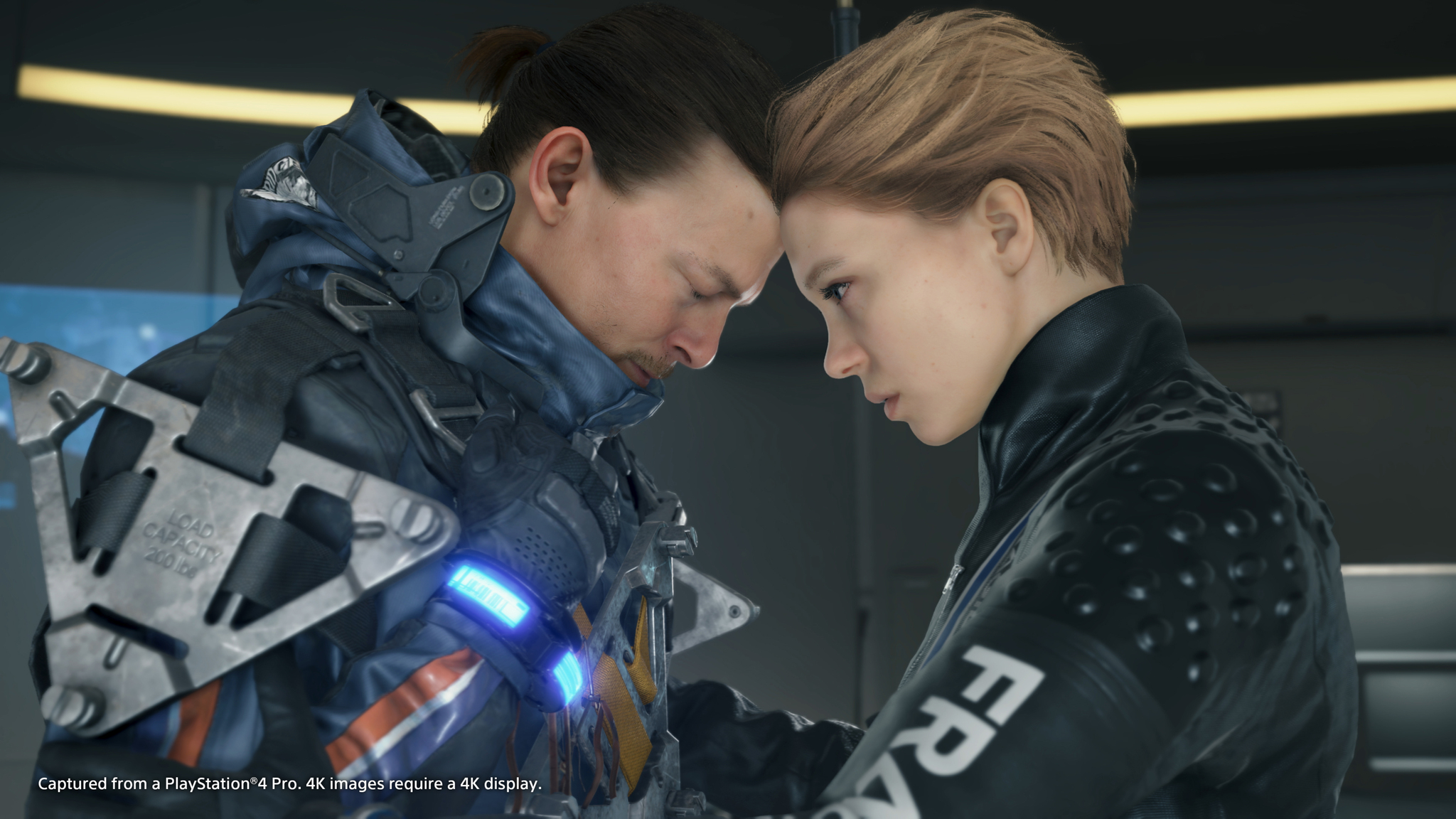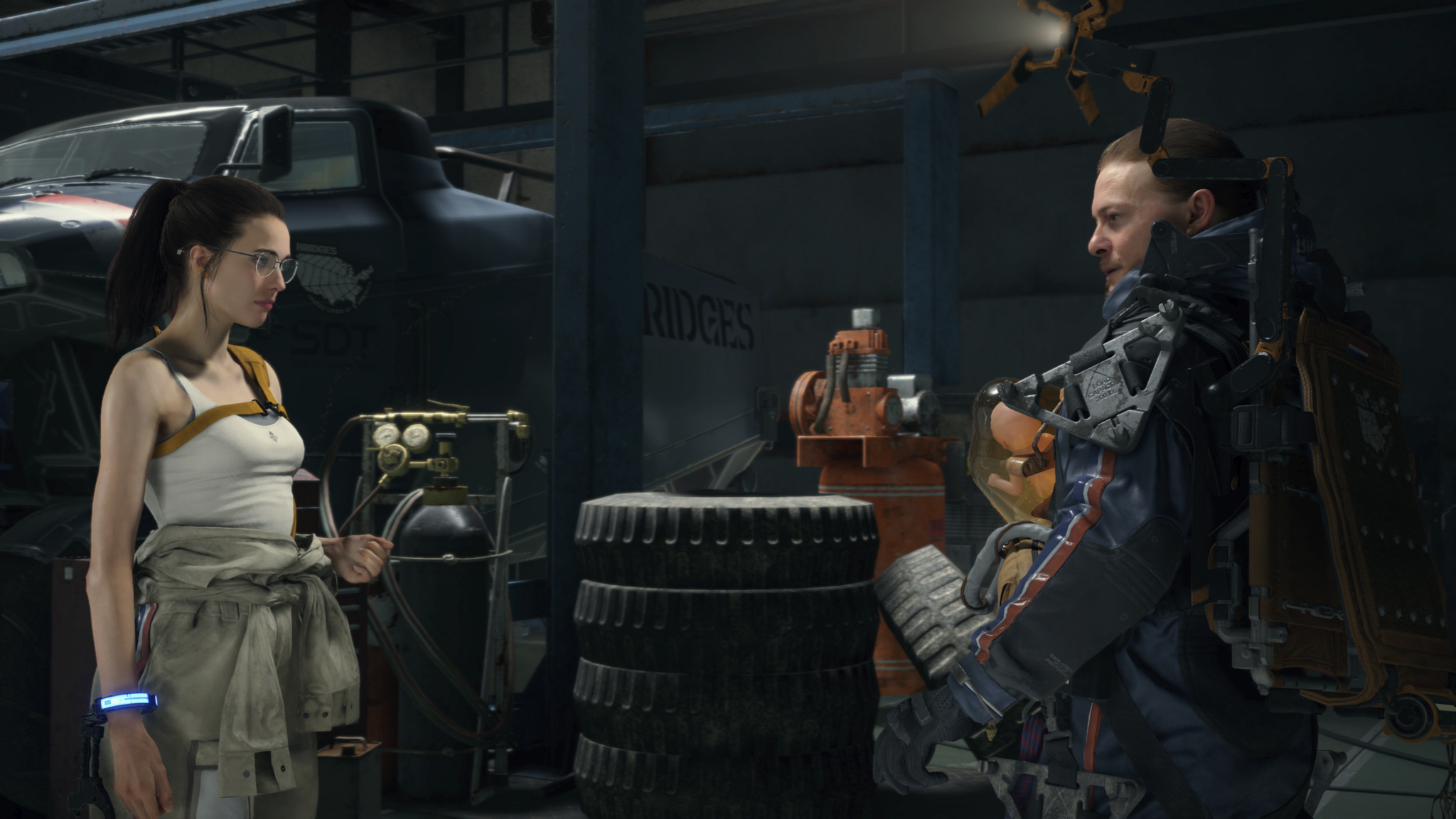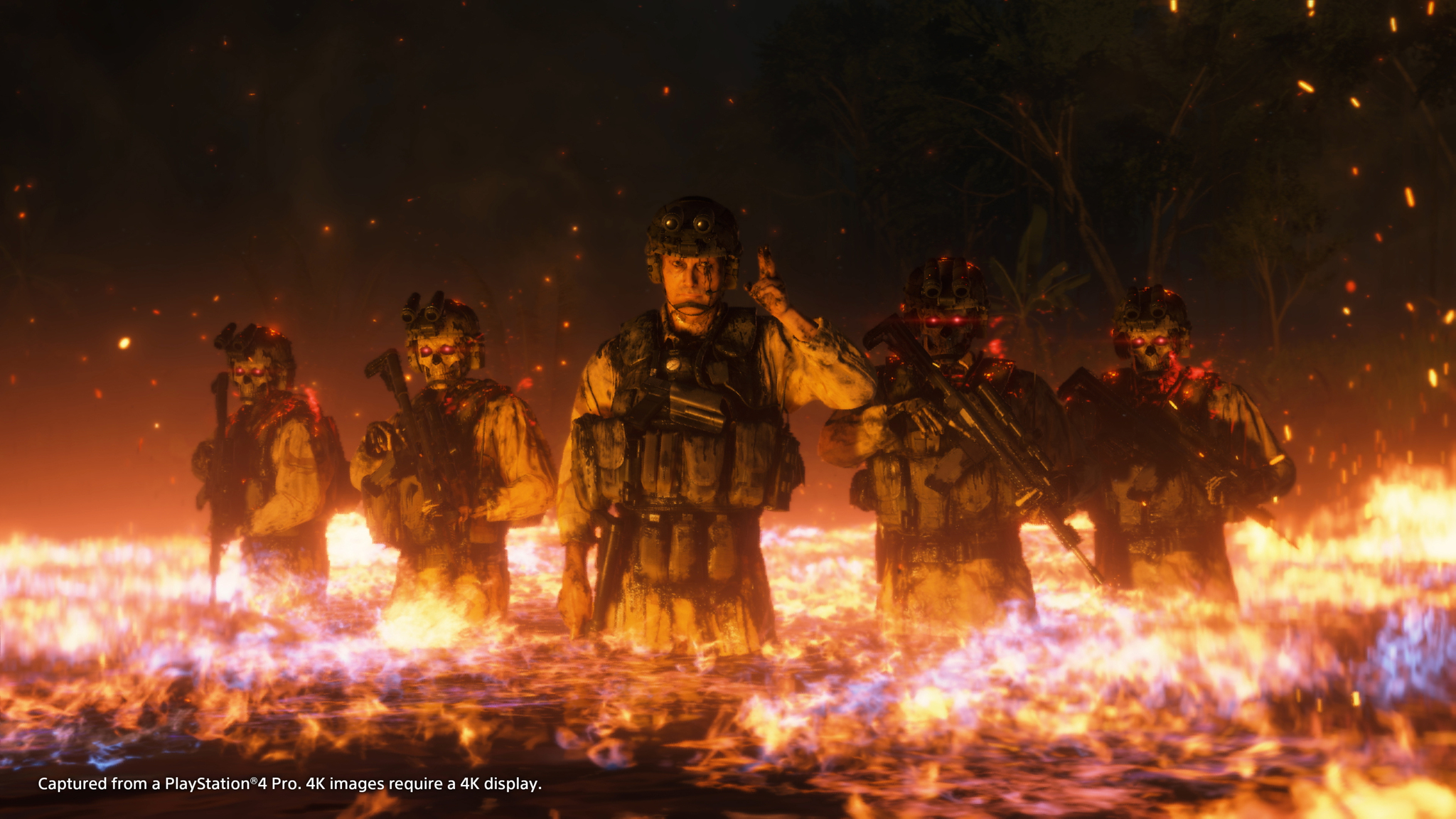I promise Death Stranding makes sense eventually. It certainly has elements that are weird and out there, but underneath all the dead sea life and ghostly figures with an affinity for black tar, there is a strong and stable narrative that threads each and every moment in the game. The world’s been divided and fragmented by a horrific event known as the Death Stranding, something that effectively thinned the veil between our world and what lies just beyond. Sam “Porter” Bridges is someone with a unique ability to sense the BTs; the dangerous apparitions that fill the distances between fractured cities. He’s also a repatriate, which means he can reconnect his soul (ka) to his body (ha) while in the Seam, bringing him back from the brink of death. Oh, and there’s also the timefall to consider, rain that accelerates the passage of time for anything it touches.
Yes, it’s a lot to take in at first. I was overwhelmed, and that’s not even half of what the game throws at you immediately. Death Stranding’s is a weird world, a beautiful yet mad fever dream with so many disparate parts that it can’t possibly make sense, right? But eventually, it does. The pieces do coalesce in time. See, Death Stranding is both a story about the broader events that have shattered the world as well as a personal story about Sam and the other characters he crosses paths with. That’s an important distinction. Both are so incredibly separate, yet so intrinsically linked.
Sam is a porter for Bridges, a delivery company that helps carry cargo across the vast swaths of uninhabitable land to the scattered people and cities. Bridges is also a part of the UCA (United Cities of America), an effort to reconnect the scattered populace of the country no matter how remote they may be. They build bridges, get it? You’ll have to forgive Death Stranding for being a little (okay, a lot) “on the nose” about some of its allegories. Its messages and themes are often far from subtle, but I learned to love the no-nonsense way that the game constantly shouted, “I’m saying exactly what I mean!” This extends to character names precisely describing them and the cities simply being named for their location. Bet you’d never guess that Die-Hardman has a hard time dying or that you need to go south to get to South Knot City.
As a porter, Sam’s job is to deliver things, and this will be a vast majority of the gameplay. Sometimes cargo will have special requirements, such as a time limit or in the case of a certain pizza delivery, needing to be carried flat. Some cargo is fragile. Some cargo is corpses. But it always comes back to Sam loading up his special backpack and trekking out across the world from one location to another, facing the dangers that the Death Stranding has left along the way.
Now I want to pause here for a moment. I’m going to talk about gameplay more, and I’m not going to be especially keen on it. I wasn’t when I first started playing and simply writing it out makes it sound dull. And it is. But in the best way? Bear with me. My time with Death Stranding was a complicated but valuable relationship and I need to explain further.
Death Stranding is not an especially “fun” game. It’s tedious at times, frustrating at others, and can feel like one of the biggest gaming slogs. It combines some of gaming’s most loathed elements—over encumbrance, inventory management, difficult terrain, fetch quests, finicky stealth mechanics—and yet I couldn’t put it down (and not just because I had to review it). I felt a need to deliver my cargo. I felt horrible when I slipped in a river and lost it all. I was scared as I carried slightly too much through BT-infested territory. I felt a sense of pride upon delivering an immaculate piece of cargo to the recipient. Even as someone who prefers to be alone, Sam is more connected than anyone, and that difficulty of drawing those connections makes the player appreciate when they get it right (and feel devastated when they get it wrong).
There’s also the whole “escort mission” that comes with having BB attached to your chest, a technically unborn baby that deepens Sam’s connection to the other side. Yet, I found serenity in simply sitting and rocking my little BB back to sleep. Many of the decisions I made in the game were made knowing I had BB to care about, and whenever I was forced to do anything that upset them, I felt horrible. The weirdness of a baby in a jar also makes sense over time, even if it does take a while to reach that moment. BB is essential and central to Death Stranding though, and in spite of the mystery, the game and Norman Reedus’ fantastic acting will force you to care.
It’s all about context. Put simply, saying “Death Stranding is delivery simulator the game” is technically accurate but lacks the deeper context to make something so mundane and silly feel so meaningful. Where most games’ use of loathed elements, like fetch quests, is simply used as filler, the so-called fetch quests are imperative within the context of Death Stranding’s story, and perhaps more importantly, what it wants the player to feel.
That story is something I can’t talk about quite yet. I’m sure we’ll be having loads of discussions surrounding it later this month but for now, I’m going to remain mum and let players discover it on their own. I promise you’ll be invested in Sam, Fragile, Deadman, Mama, Heartman and the rest. The game will contextualize and makes sense of even the most absurd elements of these characters and their stories. All of their acting is incredible. Just know that it takes some time to get moving. Like pushing a massive boulder off a cliff, there’s a lot of effort required to get it rolling, but once it gets going… oh boy, it simply doesn’t stop. When I was pushing towards what I believed to be the end of the game nearing 11 pm one night, I didn’t make it to bed until 2:30 am, and I still had to play more the next day to finish things up.
At the final stats screen, I had played nearly 50 hours. I feel that mine was an average pace to reach the end of the credits. I didn’t beeline it to the ending, but I also didn’t do and explore absolutely everything the world offered. While the first half (ish) of the game is a lot of wandering the beautiful world delivering stuff, the latter portions are a near endless stream of exposition and story moments, introducing some arguably more interesting mechanics and elements than climbing difficult mountain paths to make deliveries. (Oh, and when you get caught by BTs on that climb? Say goodbye to half your cargo.)
At first, I felt a little miffed that I had gone through countless hours of “busy work” to get to the story and more interesting gameplay, but again, it’s all in service of Death Stranding earning its payoff. That imbalance serves to better connect the player to Sam and the story, and that’s what Death Stranding is all about: connections. Like the dichotomy of the word “strand” (and its variations) having opposing definitions of leaving something alone as well as something that binds us together, the game also creates an intense sense of solitude while simultaneously never letting me feel like I’m alone in this massive world. Sam only connects with characters directly on rare occasions. Most of his interactions are through holograms at terminals, once again cementing this isolated yet connected dichotomy.
Isolated, but Connected
Further leaning into the feelings of an isolated connection with other people, Death Stranding’s online gives an eerie asynchronous life to the world around you. I delivered some of Justin Massongill’s lost cargo. I used a ladder that Greg Miller had placed in the environment. I helped PowerPyx upgrade one of his generators. I saw countless other names, some I recognized and some I didn’t, smattered across various objects, packages, and structures in the world. So many of these things assisted me, making the long treks just that much easier. I may have gone through my journey solo, but I never felt alone. In many ways, it felt like we were all working together to make the game somewhat easier for each other. Death Stranding places a lot of burdens on you, but knowing that a bunch of my friends and random porters all had my back was reassuring. Again, it’s part and parcel for why the game needs to be somewhat frustrating at a base level so that things like this can have a lot more impact. We all help each other.
In fact, in one instance, I noted that the game felt noticeably more punishing. The world felt more difficult to navigate. I assumed that I had just reached an area further in with a difficulty spike. But, while the area was more difficult to traverse, the game had somehow gone offline. As soon as I logged back in, I felt that comfort in connection. Helpful objects began appearing in the world again, and that difficult climb up a snow-covered mountain became just a touch easier, even if just psychologically.
On the other side of the coin, knowing the objects and structures I placed would help other people became one of the biggest reasons I’d opt to take extra stuff with me on any delivery. I wanted to help build the foundations of this world. I wanted someone to appreciate the perfect placement of a ladder as much as I did. It was also the reason I would go out of my way to grab their lost packages. “One good deed,” as they say.
The online interactions even began to physically change the world. Just like in the real world, you’ll see paths start to mark themselves and get worn down where more players frequently walk, guiding you along the most common and presumably safest routes. Signs left by players warn of areas with BTs or deceptively deep water. Sometimes there’s even just a cheerleader sign that restores your stamina after a particularly tough climb. Your own signs don’t do anything for you, but dropping that “keep on keeping on” marker for the next player who makes the difficult trek is a great feeling. You know they’ll appreciate it.
Playing the inventory management game becomes much easier when you know you can leave gear in “Share Lockers” for other players to use at their convenience. When I upgraded to an all-terrain exoskeleton, I left my old speed skeleton in a locker so that some other player could get use out of it. When I was done using a floating cargo carrier, I would drop it off for the next person that maybe was carrying just a bit too much. I used multiple vehicles that other people left in the online garages. I made it a point to always check what the Share Lockers had and decide what I did and didn’t need. I rarely had to fabricate items of my own this way and could recycle unused and found objects back into the online economy. I was playing alone, but I was playing online. It was a really unique feeling.
Metal Weird Solid
At a core level, Death Stranding obviously came from the creator of Metal Gear Solid. Having put an absurd amount of time into Metal Gear Solid V, I noticed an exceptional number of similarities to that last game in the series (no, we aren’t even considering Metal Gear Survive here). The mission prep screens, inventories, item icons, and many of the sound effects feel adapted from Hideo Kojima’s experience with MGSV. Even Sam’s movements and the general design of technology and elements in the world were clearly influenced by Kojima’s development history. In some ways, Death Stranding feels like the game Kojima was originally trying to create with Metal Gear Solid V, yet is wholly unique in its own way too.
If there’s one element that’s not made better by Death Stranding’s payoff, it’s the poor vehicle mechanics. I get that vehicles shouldn’t suddenly make the game excessively easy, but vehicles are persistently finicky and inconsistent with how they handle various terrains and weather. Odd physics meant that my vehicles would suddenly pop into unintended positions, sometimes to my benefit, and sometimes to the detriment of every package I had loaded on board. This was the one frustrating element of gameplay that was never “redeemed” by finishing the game.
I also had frequent bouts of frame hitching, noticeable enough that even my wife would glance at the TV occasionally and see it. This happened most often when I was driving quickly along long stretches but occasionally occurred while on foot too. I should note that I was playing on an original launch PS4, so performance may be improved on a PS4 Pro or even a newer PS4 Slim. For the most part, the game ran without issue though, and the frame hitching was never egregious. It simply seemed like it was dropping every other frame, and I honestly questioned if I was even seeing it right at first. Overall, I was impressed with the performance my little ol’ “Launchy” was able to pull out of this game, but it’s a good thing next-gen is just around the corner. We’re hitting the tail end of what’s possible on the base PS4.
Music implementation in Death Stranding is a great new take on traditional soundtracks, with new songs unlocking and playing dynamically at certain moments that enhance the wonder of the journey or emotion of the moment. I only lament that there isn’t any kind of music player in the game so that I can choose what tracks to listen to (outside of Sam’s private room), and menus stopped the track that was playing. Sam’s journey is fantastically backed by a large selection of songs from Low Roar, among a few other artists, but it’s all limited to being out in the world or just sitting in your private room doing nothing. It’s a huge step back from how Metal Gear Solid V implemented music in-game, allowing you to choose from your unlocked tracks and letting them play no matter what you were doing in menus. Especially in the post-game, I want to be able to listen to these tracks as I continue to play.
And yes, I want to continue to play. Even after I was finished, I hopped right back into Death Stranding with a renewed vigor. I can’t go into too many details for the sake of spoilers, but there’s a good amount of replayability. Just completing the story gave me new motivations to go back and contribute to the online economy of Death Stranding and to make the tough treks to increase my connection rating with various people and cities. Even without the driving force of the narrative mystery, dare I say that I was having fun simply being a delivery boy? Again, it’s all about context, and the previous 50 hours defined my next 10.
Death Stranding is not a “fun” game, but it’s an important and meaningful experience that earns its payoff through every bit of frustration and slog. It’s a look at life and death, connection and solitude; a game about building up what matters most and supporting each other selflessly. You’ll be bored at times and downright frustrated at others, but it comes with a great reward at the end that is made sweeter by the trials that precede it. It’s brilliantly unique in its design and implementation of online elements. Even if it’s got a few places where it stumbles, Death Stranding firmly holds down R2 and L2 to regain its balance and deliver an unmatched experience.
Death Stranding review code provided by publisher. Reviewed on a launch PS4. For more information on scoring, please read our Review Policy.
-
Unique experience that earns its payoff
-
Online interactions give a sense of connected isolation
-
Fascinating story featuring fantastic acting
-
Important and meaningful message
-
Odd vehicle physics
-
Takes a long time to get going; players have to be patient















